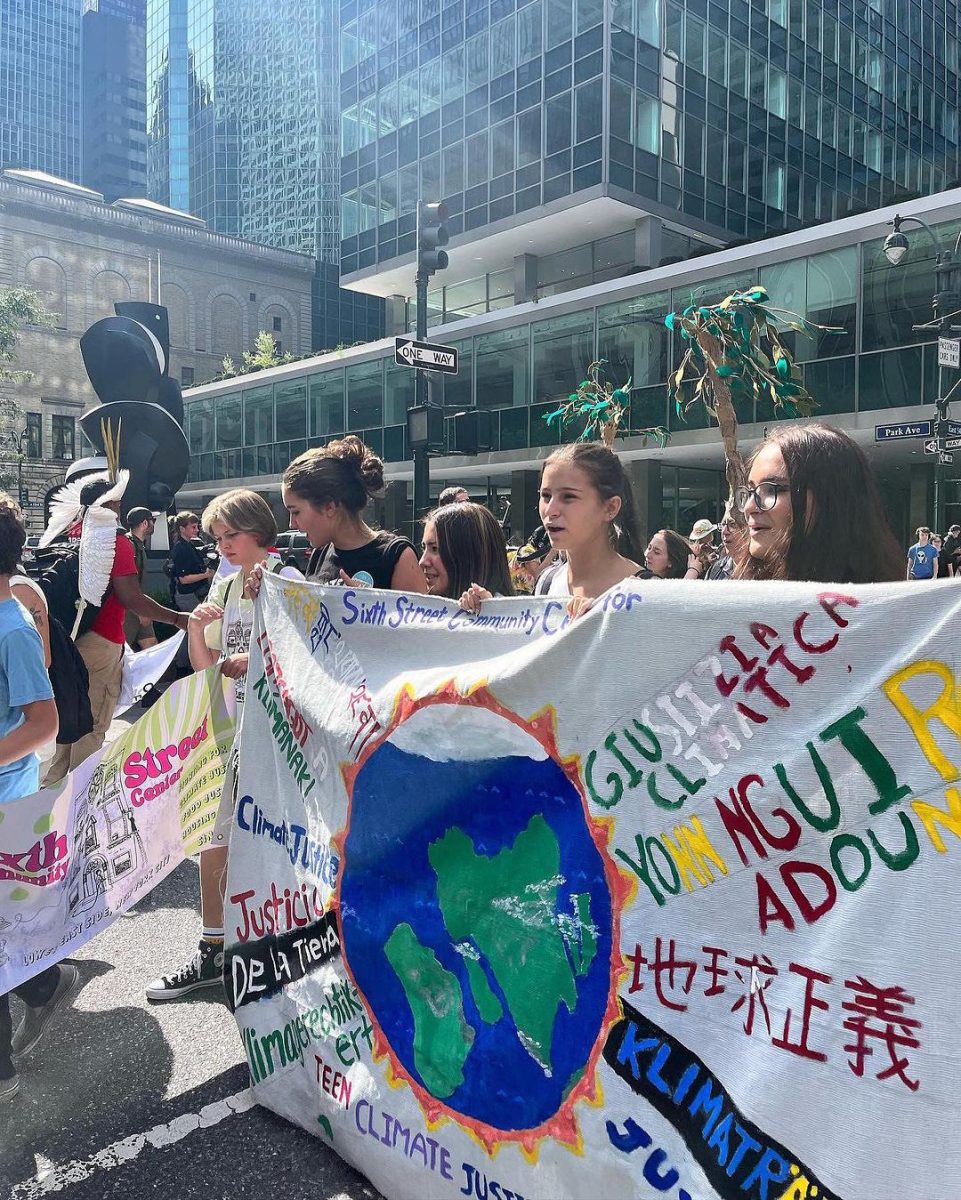On the corner of 6th Street and Avenue C in Manhattan is a long wall covered in graffiti. It’s striking when compared to its environment — blue-painted bricks covered with a myriad of tags, colors, and shapes surrounded by the red-browns and beiges often seen in residential areas downtown. Go around the corner, and you’ll be met with a parking lot. Beyond that is a sign stating “FREE FOOD” in English, Spanish, and Chinese, nestled next to a brick building with people and shapes painted in bright, swirling colors. Once a month, there is a long line of people spanning the block and curling around the blue wall, each with either a bag, cart, or stroller. A majority of them are elderly Asians. Peek into the side space where the fence sign is, and there will be a group of people taking produce out of stacked boxes and placing them into carts and bags, handing them to people at the front of the line. At Sixth Street Community Center, their monthly food distribution always marks a busy day.
Located on the Lower East Side of Manhattan, also called the Loisaida, the Sixth Street Community Center’s main focuses are mutual aid, grassroots organization, and youth climate education. The Lower East Side has been a historically lower-class worker neighborhood housing many immigrants, and it still has many low-income families living in it today. In 1978, a group of mothers in the Lower East Side formed a block association when they were struggling to keep their children sufficiently fed. After years of fundraising, they purchased and restored an abandoned synagogue, which they transformed into a center for the community.
Since its founding, the center has strived to foster community development with after school and summer programs, with tenant advocacy, and with aiding individuals in developing life skills and working on career development. Gradually, the community center’s work has evolved to involve the community in projects for environmental advocacy, sustainable living, and in ensuring that individuals have access to sustainable, healthy produce.
Much of the community center’s mutual aid comes in the form of supporting food sovereignty. This means ensuring that as many low-income families have access to as much fresh, healthy, and culturally appropriate food as possible. “We want to be a place in the Lower East Side where people can come and really get involved with justice work in general, and always be grounded to what the community right here in the Lower East Side needs,” said Anna Tsomo-Leidecker, pronouns she/they, Director of the Teen Climate Justice Program and the Teen Summer Program at the Sixth Street Community Center. The community center has two youth programs, created to educate the young regarding climate change and to get them involved with the community center’s mutual aid efforts.
The community center’s youth programs run after school, one for ages 5-11, and the other for high schoolers. The students there often help with the community center’s food rescue and distribution efforts alongside the staff. These past few summers, the community center has opened up a summer program for teenagers to more deeply and consistently educate youth.
Last year, the teens at the center created a crate garden with native pollinator plants for the beehives, both placed on the roof of the center. Occasionally, the youth will go to the 6BC Botanical Garden next door to water other native pollinator plants on the plots they own.
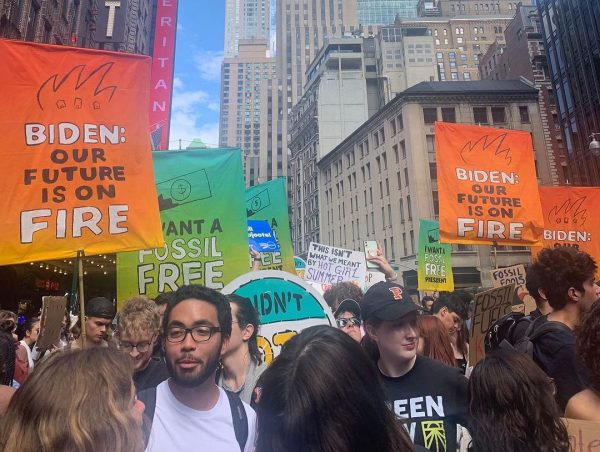
Beyond this, the community center often invites queer and/or POC climate activists to talk on various climate topics to well-equip the youth with a wealth of knowledge on climate justice. “I want the teens in the program more than anything to realize how real climate change is,” said Tsomo-Leidecker. They say that their hope, and the center’s hope as a whole, is that what they learn within these programs will transcend beyond climate justice and food sovereignty, and that “the program will give people real tangible skills that will help them when the world starts to really change.” For example, Tsomo-Leidecker said, that the program addresses “organizing skills, tangible skills, information about what is actually causing climate change…what’s going wrong, who’s at fault, and how we solve it… And even…skills like knowing how to monitor air quality, what website to go to when we have these kinds of freak bad air quality incidents happen, or…if there’s somebody in your community who doesn’t have enough food, which community fridges to point them to…[We address] how to be an organizer in that way, and to see themselves as organizers in that way.”
In addition to their grassroots activism, the center has advocated for greater social, political, and economic change. The community center’s youth program has been involved with many political protests and lobbies, such as lobbying for the Climate, Jobs, & Justice Package at the Million Dollar Staircase in Albany, testifying for laws such as Local Law 97, and marching along and providing banners for the administrators of the March to End Fossil Fuels on September 17th, 2023. “I hope to continue to inspire more teens in the climate space and help them engage with politics in a meaningful way,” wrote Hennessy Garcia, pronouns they/she, a facilitator of the Teen Climate Justice Program.
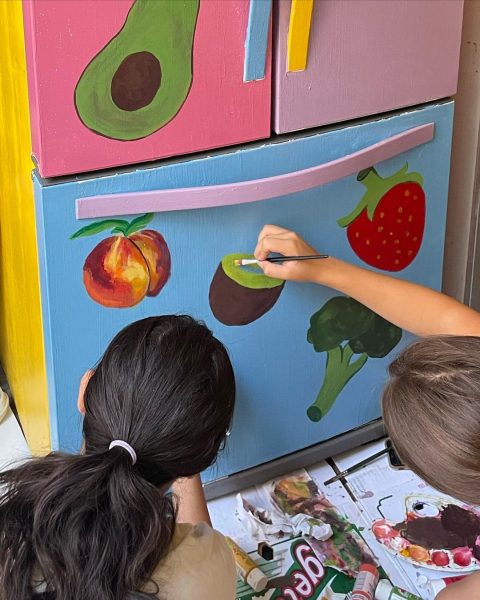
Beyond their educational programs for youth, the center also conducts many other programs to support the community’s food sovereignty.
One major feature of the center is their community refrigerator. Community fridges are maintained with the goal that people will be able to take free food from the fridge at any time if needed. The one at Sixth Street is located in the side yard next to the main building, and is accessible Mondays to Fridays, from 11 a.m. to 4 p.m. Occasionally, they conduct food rescues from the Union Square Trader Joe’s, where they pick up fresh produce that would have been thrown out otherwise, in order to stock multiple community fridges in the neighborhood, including their own. These food rescues are often done in collaboration with their youth programs.
Another way that they stock the fridge is through their Community Supported Agriculture (CSA) program, which provides access to fresh, organic local produce to the center from Hepworth Farms in the Hudson Valley. Individuals can then buy produce themselves using SNAP or EBT.
The community center shares its commercial-grade kitchen with an organization called EV Loves NYC. Together, they provide 2,000 free meals per week. The community center often provides these meals to the community fridges within the neighborhood. So far, they have prepared over 200,000 meals at the Sixth Street kitchen.
They sometimes fill the fridge using leftover produce from their food distributions. Their food distributions started during the COVID-19 pandemic, initially handing out food boxes distributed by the FDA.
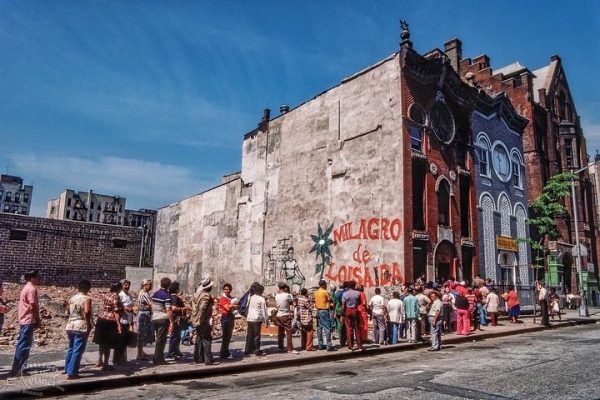
When they started the distributions, they came upon a frequent issue: much of the food being provided was incompatible with the diets of the majority East Asian population that came to their distributions. There were many bread and dairy products included, which often ended up going to waste. Now, Sixth Street Community Center has decreased its food distributions to a once a month schedule, after the FDA ceased distributing food boxes. They are now partnered with Tay Shing Corporation, a company that specializes in Asian produce based in Flushing, New York, so that the produce being distributed better suits the community’s needs.
Individuals are welcome to volunteer for food distributions here, whenever they desire to participate in mutual aid. The community center is thankful that individuals are interested in mutual aid, but they also hope that the volunteers can be consistent in any mutual aid efforts. This allows the community individuals are volunteering in to build a network of trust. “If you show up over and over again, the community starts to know you… people start to trust you and that’s when you’re able to… build those really meaningful relationships,” said Tsomo-Leidecker. “Reaching out to people that you may know locally where you live, or where you work, and then trying to show up and just be there…be a body and meet people, have a good attitude, and make those connections…the rest kind of comes naturally,” she said.
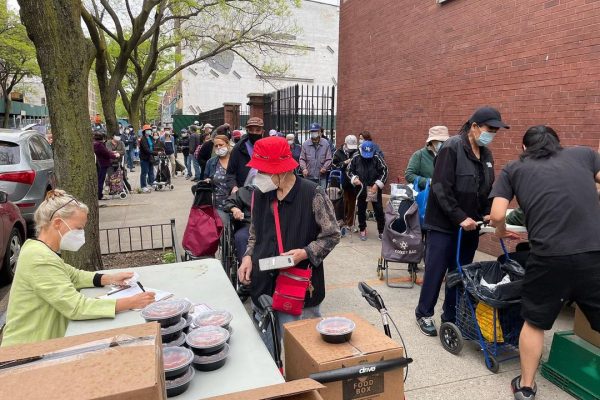
In the end, what the center wants people to pull from their experience at the community center is the following idea: “I know how to build a community and… organize people to get something done… I know how to be a leader and listen to other people’s opinions and come to a consensus in a group. That’s…a skill that… applies across the board, no matter what’s going on, because you always need other people to survive,” said Tsomo-Leidecker. At their core, the community center focuses on exactly what their title states. Building a community where people help each other in times of need is the first key to creating a safe, flourishing planet for all.
“Reaching out to people that you may know locally where you live, or where you work, and then trying to show up and just be there…be a body and meet people, have a good attitude, and make those connections…the rest kind of comes naturally,” said Anna Tsomo-Leidecker, Director of the Teen Climate Justice Program and the Teen Summer Program at the Sixth Street Community Center.

